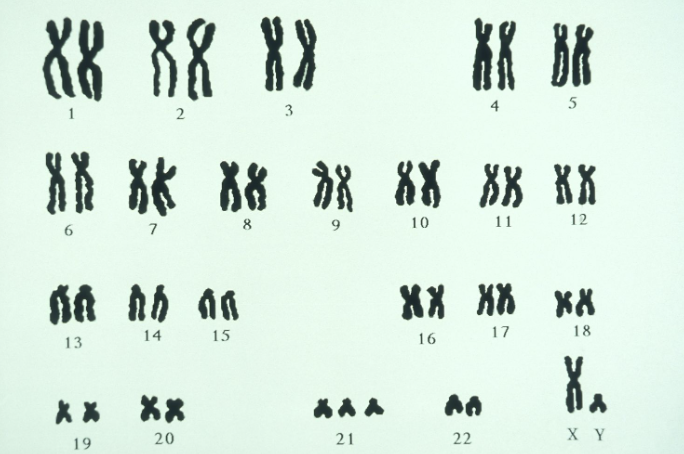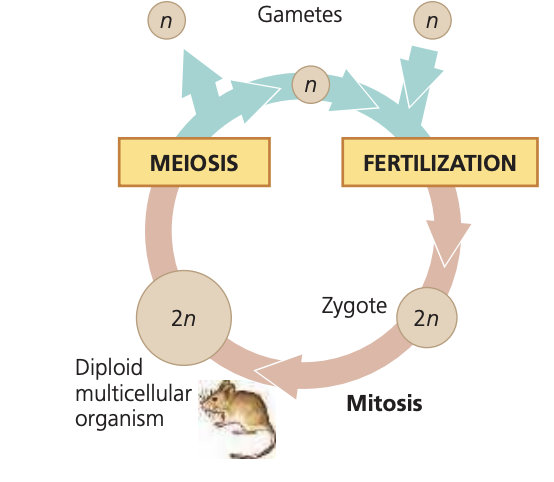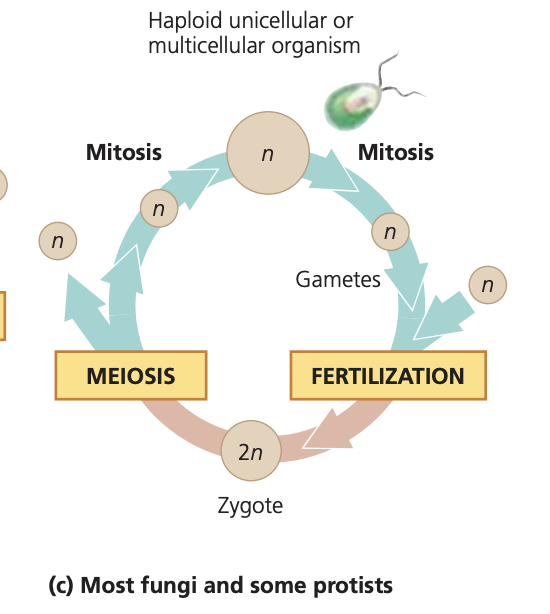Ch 13 BIO MO2A
1/23
Earn XP
Description and Tags
Name | Mastery | Learn | Test | Matching | Spaced |
|---|
No study sessions yet.
24 Terms
genes
a specific sequence of DNA that acts as the basic unit of heredity, containing instructions to build proteins which ultimately determine an organism's traits like eye color or height
Gametes
a reproductive cell, also known as a sex cell, which is produced by an organism and fuses with another gamete during fertilization to create a new individual
somatic cell
any cell in the body of a multicellular organism that is not a reproductive cell
locus
the specific location on a chromosome where a particular gene is found; essentially, it's the physical address of a gene on a chromosome, defining its exact position within the DNA sequence
Sister chromatids
the two identical copies of a chromosome created during DNA replication, which are joined together at the centromere and separate during cell division to ensure each new daughter cell receives a complete set of chromosomes
Homologous chromosomes
a pair of chromosomes, where one chromosome comes from the mother and the other from the father, carrying the same genes at the same loci, meaning they are structurally similar and contain the same gene sequence,
asexual reproduction
method of reproduction where offspring are produced by a single parent, resulting in genetically identical copies of the parent, also known as clones; the main benefit of asexual reproduction is the ability to rapidly increase a population in favorable conditions by not requiring a mate and producing numerous offspring quickly
three ways that sexual reproduction contributes to genetic diversity
crossover, random assortment of homologous chromosomes, and random fertilization
diploid
a cell that contains two complete sets of chromosomes, meaning it has two copies of each chromosome, one set inherited from each parent; in humans, most body cells (somatic cells) are diploid, containing 46 chromosomes in total (23 pairs)
haploid
a cell that contains only one set of chromosomes, meaning it has a single copy of each chromosome; in humans, this refers to sperm and egg cells (gametes), which each have 23 chromosomes, making them haploid cells.
meiosis
specialized cell division process that occurs in reproductive cells, producing four haploid daughter cells (gametes) from a single diploid cell, allowing for the creation of sex cells like sperm and eggs, which are crucial for sexual reproduction by ensuring the correct number of chromosomes in the offspring when they fuse during fertilization; the resulting cells are haploid because each daughter cell receives only one copy of each chromosome pair from the parent cell, halving the chromosome number
in animals; gametes (sex cells), specifically sperm cells in males and egg cells (ova) in females
what karyotype shows
a visual representation of an individual's complete set of chromosomes, allowing doctors to analyze the number and structure of chromosomes to identify potential genetic abnormalities, including trisomy, where an individual has an extra copy of a specific chromosome, appearing as three copies instead of the usual two in a pair; on a karyotype, trisomy is easily identifiable by seeing three distinct copies of a particular chromosome instead of just two

when DNA replication occurs in the meiotic cycle
occurs only once, during the interphase stage, specifically in the S phase, before the start of meiosis I; meaning the replication happens prior to the first meiotic division and is not repeated again during the subsequent stages of meiosis II
when and how sister chromatids remain attached
from the time they are created during DNA replication in the S phase of interphase until they are separated during anaphase of mitosis, held together by a protein complex called cohesin at the centromere region, ensuring proper chromosome segregation during cell division; this attachment is crucial for the correct distribution of genetic material to daughter cells.
what is separated during meiosis I
homologous chromosomes are separated from each other, while the sister chromatids within each chromosome remain together; this is the key distinction of meiosis I, where the cell effectively reduces its chromosome number by half.
what is separated during meiosis II
the sister chromatids of each chromosome are separated, resulting in the formation of four haploid daughter cells, each with a single copy of each chromosome.
three events unique to meiosis that occur during meiosis I
the pairing of homologous chromosomes, crossing over between non-sister chromatids, and the alignment of homologous chromosome pairs (tetrads) at the metaphase plate
TWO reasons why synapsis and crossing over are important
facilitate genetic diversity by allowing the exchange of genetic material between homologous chromosomes during meiosis, ensuring that each gamete receives a unique combination of alleles, and promoting adaptation within a species
differences between mitosis and meiosis
Mitosis is a cell division process that produces two genetically identical daughter cells from a single parent cell, while meiosis is a cell division process that produces four genetically distinct daughter cells with half the number of chromosomes as the parent cell
reproductive cycle of an animal

zygote
fertilized egg cell that results from the union of a female gamete (egg, or ovum) with a male gamete (sperm)
the alteration of generations in plants and some algae.
a life cycle where an organism alternates between two distinct multicellular phases: a haploid gametophyte generation that produces gametes (sex cells) and a diploid sporophyte generation that produces spores,
what sporophytes and gametophytes are.
sporophyte; the diploid, multicellular stage in the life cycle of a plant or alga that produces spores, alternating with a haploid gametophyte stage; essentially, it's the phase of a plant that generates spores through asexual reproduction, while the gametophyte produces gametes for sexual reproduction.
reproductive life cycle of fungi and protists
